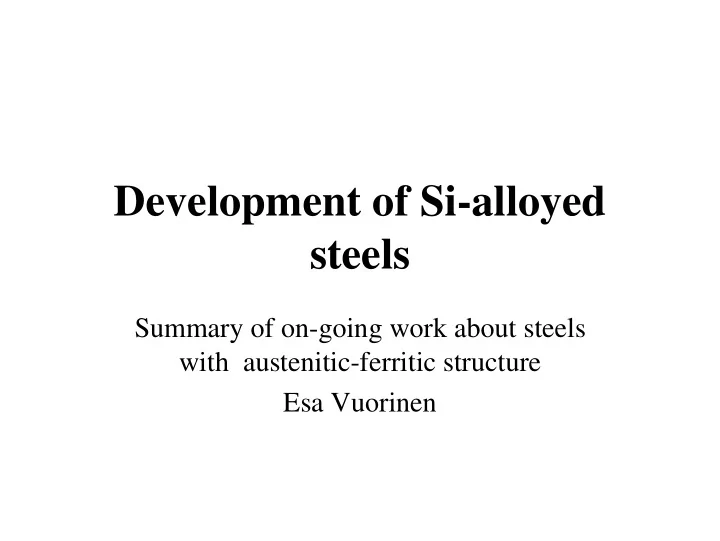

Development of Si-alloyed steels Summary of on-going work about steels with austenitic-ferritic structure Esa Vuorinen
Austempered Si-alloyed steel Austempering of Si-alloyed steels creates a carbide-free structure consisting of austenite and ferrite Ausferrite
Ausferrite Fine grained carbide-free micro-structure consisting of retained austenite and ferrite, achieved by austempering at 340 o C for two hours Steel 55Si7
Work performed • Mechanical properties • Sliding wear resistance • Laser hardening • Rolling-sliding wear resistance • High-temp in-situ X-ray study of austempering process
Austempering of Si-alloyed Steels
Effect of Heat Treatment Fe-0.56C-1.90Si-0.84Mn-0.19Cr-0.11Ni Hot rolled Austempering, 340 o C, 2h Yield strength, R p0.2 612 MPa 1240 MPa Ultimate strength, R m 1047 MPa 1530 MPa Hardness 338 HV0.3 485 HV0.3 Elongation, A 10 13 % 12 % Reduction in area, Z 40 % 58.5 % Impact energy, KV 12 J 20 J Improved mechanical properties, with maintained ductility
Toughness • Impact toughness • Fracture toughness K IC = 50-85 MPa(m) ½ KV = 20 J at for castings (litterature- T = -40 0 C for values) R m > 1500 MPa K IC < 130 MPa(m) ½ for (values for a steel with rolled and heat treated 0.55%C, 1.9%Si) steels Ductile fracture (litterature -values)
Wear resistance • Strain hardening & transformation of austenite to martensite contributes to the wear resistance of this group of steels • Better wear resistance in comparison to boron-steels with same hardness. • Good tempering resistance. • Surface hardened components with high core strength can be produced
In-situ X-ray observation C Xiang Experiments with low C (0.32wt% and high C (0.83 wt%) has been performed
In-situ X-ray observation • The amount of • The carbon content ferrite as a function of ferrite and of time at different austenite has been temperatures has determined as a been measured function of time
In-situ X-ray observation • The austenite amount • C-content in austenite increases from 240 o C to decreases with 320 o C but decreases transformation temperature from 400 o C then sharply for 360 o C to 240 o C and 400 o C • 0.9%C � 1.1%C • � 0.5%C and 0.3%C
On-going work • Wear resistance as a function of the amount of austenite in the ausferritic structure; – Transformation at different temperatures – Different amount of austenite – Rolling-sliding test – Microstructural changes
New projects 2008-11 • RFCS • RFCS Low C-Si Steels High C-Si Steels • Div of Eng Materials • Div of Eng Materials & Solid Mechanics & Mat Mechanics & Machine Elements • Goal: • Goal: – Ductility – Fatigue resistance – Weldability – Wear resistance – Strength & Toughness – Strength & Toughness
Recommend
More recommend